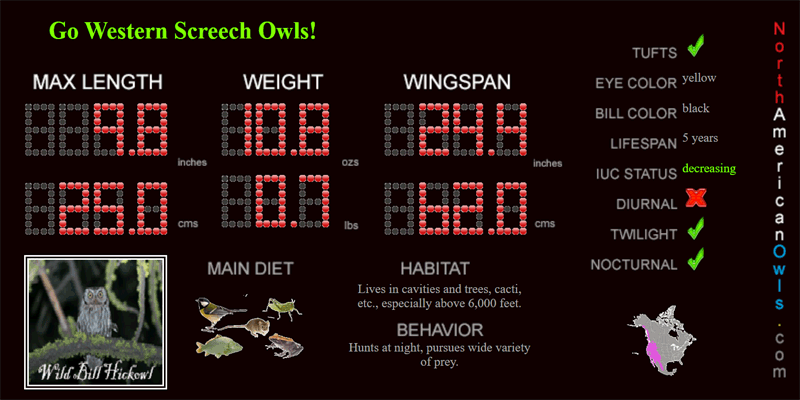
photo credit: Jeremiah Psiropoulos
Western Screech Owl wins for Best Stocky Owl
January 21, 2025
It finally happened, pardna! They finally recognized us Western Screech Owls for our stocky bodies and our square-shaped heads. What? You didn't hear? My species won the award last night for Best Stocky Owl with a Square-ish Head at the North American Owl Awards ceremony. It's one of the most daggone coveted awards that they give out, pardna! I mean, come on, padre, what rock have YOU been living under?
I beat out the Boreal Owl, by the way, who was also nominated for that thar category. As if Strix varia even had a chance, right, pardna? Their bodies are clearly less stocky than ours and their heads are at least slightly rounded at the top. No, pardna, if you want stocky and square-shaped, then the Western Screech Owl is your man -- or your owl, or whatever.
But you don't have to treat me like royalty, pardna, just because I won this har Golden Owl Pellet Award. I'm still just an everyday Western Screech Owl doing my omnivorous thing out here in the western half of the United States of America. I still eat the same mammals, amphibians and songbirds, the same way I always did, without any fancy seasonings like salt and pepper and without using any of them thar fancy doodads what you human beings call u-tensils. And if I wore trousers, pardna, I'd put them on one leg at a time, just like you.
Still, you should have heard my acceptance speech. I had the audience eating out of my hands... or out of my beak or whatever. But don't take my word for that, pardna. Listen to this here recording of the awards ceremony, live on tape from Zimman Field at Tufts University in Medford, Massachusetts!
January 21, 2025
It finally happened, pardna! They finally recognized us Western Screech Owls for our stocky bodies and our square-shaped heads. What? You didn't hear? My species won the award last night for Best Stocky Owl with a Square-ish Head at the North American Owl Awards ceremony. It's one of the most daggone coveted awards that they give out, pardna! I mean, come on, padre, what rock have YOU been living under?
I beat out the Boreal Owl, by the way, who was also nominated for that thar category. As if Strix varia even had a chance, right, pardna? Their bodies are clearly less stocky than ours and their heads are at least slightly rounded at the top. No, pardna, if you want stocky and square-shaped, then the Western Screech Owl is your man -- or your owl, or whatever.
But you don't have to treat me like royalty, pardna, just because I won this har Golden Owl Pellet Award. I'm still just an everyday Western Screech Owl doing my omnivorous thing out here in the western half of the United States of America. I still eat the same mammals, amphibians and songbirds, the same way I always did, without any fancy seasonings like salt and pepper and without using any of them thar fancy doodads what you human beings call u-tensils. And if I wore trousers, pardna, I'd put them on one leg at a time, just like you.
Still, you should have heard my acceptance speech. I had the audience eating out of my hands... or out of my beak or whatever. But don't take my word for that, pardna. Listen to this here recording of the awards ceremony, live on tape from Zimman Field at Tufts University in Medford, Massachusetts!

Westward Ho!
December 24, 2024
Howdy, Pardna! Wild Bill Hickowl at your service, fixing to tell you cowpokes a passel o' fun facts about yours truly, the Western Screech Owl, aka Megascops kennicottii. So grab a log stump by that thar campfire here in the Sonoran desert and prepare to be impressed. I'm over here in this Saguaro cactus, by the way, gazing out from this hole that has been generously carved out for me by a Gilded Flicker... or was it a Gila Woodpecker1?
Over here! I'm about 10 feet off the ground. You can't miss me! Or rather you can easily miss me, on account of how my gray-brown feathers blend in with the dried-up portions of this cactus that surrounds my nest opening, the so-called "callus," as your dendrologists call it. I'm a master of camouflage, you know.
Just look for a pair of big yellow eyes staring at you guys from about 10 feet off the ground to your left. No, your OTHER left. Over here!
Yep, it's me! The Western Screech Owl, also known as the Dusk Owl, the Ghost Owl, and the Little Horned Owl2. I'm also called Kennicott's Owl3, in honor of the 19th-century zoologist who first classified me. That's why my species name is "kennicottii," by the way, which is, of course, the classical Latin way of saying "discovered by Kennicott" or "Kennicott's owl."
What? Didn't you know that we Western Screech Owls know Latin? What are they teaching you in those schools of yours, anyway?
And now fun fact number one, pardnas: my territory.
You can basically find me everywhere. We western Screechies set up shop from extreme western Texas to California and then north to Alaska by way of the British Columbian coastline. We can be found in woodlands, riparian forests, suburbs, city parks, coastal zones, and even cactus groves like this'un here. How's that for adaptability4?
Oh, thank you, but please hold your applause until the end of my spiel. I've got a lot of other admirable traits, too, as shall soon become apparent. You can just applaud me for everything at once after I'm done.
Fact two, padres and madres: My eyesight.
I have excellent binocular vision5 and I can distinguish prey in low light6. The only catch is that I can't move my eyes in my head and so I am obliged to move my entire head in order to see what's around me. The cool thing is that I can rotate my cabeza a full 270 degrees, though7. See for yourself. Here I go! Look, I can turn it a full 270 degrees! Whoop, there it is! Ha ha!
Not bad, huh?
This ability of mine has given rise to the myth that I can spin my head 360 degrees, all the way around in a complete circle. That's not true, of course, but we owls can give you that impression, especially when we follow up a spin to the left with a spin to the right, both to the maximum extent possible. But 270 degrees is really all that we need for the practical purposes of spotting prey and detecting predators.
Besides, can you imagine the skeletal architecture that would be required to perform a complete head spin? We owls already have twice the number of vertebrae in our necks as you humans possess in order to meet the current requirements for head-spinning. Imagine if we could spin 360 degrees: our necks would be positively bursting with vertebrae8.
Fun fact 3: my hearing.
Like most owls, we Western Screechies come custom-equipped with asymmetrical ear holes what allow us to pinpoint sounds coming from any angle -- something that your scientists call triangulation, I believe9. Facial discs are also a standard feature on all Western Screech Owls. They act like radar dishes to funnel sounds to our ears, which are located under the feathers located close to our enormous yellow peepers10.
Now, I know what you ornithological greenhorns are thinkin'. You thought that my ears were located on top of my head, didn't you? Come on, be honest.
Well, not a bit of it, pardna! Owl ears are located near our eyes and are hidden behind the feathers of our facial disc. What you're callin' ears are actually my ear tufts, amigos. They're just feather-covered projections that we screechies can raise or lower as we see fit11. Western Screech Owl ear tufts are rather short, I'm afraid, just a few inches in length. But look here, I'll raise them for you. See? It makes me look perky, don't it? And now when I lower them like THIS... I look forlorn, don't I? See? Ear tufts up... perky... Ear tufts down... forlorn. Just remember, though, amigos, they are ear TUFTS, not ears!
Fun fact 4: my cousin.
I am closely related to the Eastern Screech Owl, so closely, in fact, that we used to be considered the same species until the 1980s12. That's why we're hard to tell apart. Both Eastern and Western Screech owls are small, about the size of a beer glass. We both have small ear tufts and a somewhat flat-looking head. And we both have no neck to speak of, to be honest.
So how do you tell us apart, you ask?
That brings us to fun fact number 5: my calls.
The go-to call for we Western Screech Owls is a kind of monotonous tooting that increases in tempo, putting one in mind of a bouncing ball13. This is quite different from the trademark call of the Eastern Screech Owl, which is said to resemble the whinnying of a toy horse, or of "a horse on helium," as the Audubon Society would have it14.
Ta-da!!! Not bad, huh?
Ladies and gentlemen, I give you Megascops kennicottii, the Western Screech Owl! Thank you very much. Oh, thank you so much!
Well, go on, amigos, you can applaud now!
But hold on a minute. Did anyone else just hear some deep soft hoots in the distance? Wait! Hear that? It's got a sort of stuttering rhythm to it.
Why, bless my soul, I do believe that that is one of the many calls of my species' archnemesis, the Great Horned Owl15.
That brings us to fun fact number 6 -- our predators -- though personally I don't see anything fun about it.
We Screech Owls are preyed upon by other owls16. I know, it's embarrassing, right? You'd think that there'd be some sort of fellow feeling between raptors of our kind, but no such luck. We can be attacked by Barred Owls, Spotted Owls, Great Horned Owls, and even Snowy and Great Gray Owls in Canada and Alaska. That's why we spend the day in our nesting cavities -- in trees or cacti or whatever. We don't want to fall victim to territorial rivals.
Oh, dear. There's more of that syncopated hooting and it's getting closer. Lands agoshen! I think it's time for me to make like a banana and split. So adios for now, amigos. But do me a favor, pardnas: if the Great Horned Owls should actually show up, point out toward the desert yonder and tell 'em that I went that-a-way!
1: Nest-site selection by Western Screech-Owls in the Sonoran Desert, Arizona, Brigham Young University
2: Interpretive Animal Information: The Western Screech Owl, Arizona-Sonora Desert Museum
3: Western Screech Owl, The Owl Pages
4: Western Screech Owl, Audubon
5: 'Owl' Be Seeing You: Amazing Facts About Owl Eyes, American Bird Conservancy
6: Journeying through the Life of the Western Screech Owl, Rarest Birds
7: Owl Eyes & Vision, The Owl Pages
8: Owl Skeletal System, The Owl Pages
9: Owl Prowl, Audubon Adventures
10: How Do Owls, Animal Researcher
11: A Look Into Owl Anatomy: Do Owls Have Ears?, Birds Authority
12: Western Screech Owl, Audubon
13: Western Screech Owl Song, Bird-Sounds.net
14: Learn to Identify Five Owls by Their Calls, Audubon
15: Great Horned Owl Sounds, Cornell Lab: All About Birds
16: What are the predators of the Western Screech-Owl?, Reptile Knowledge
copyright 2024 by Brian Quass.
contact: quass@quass.com.
